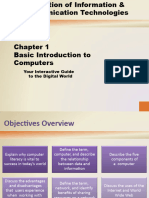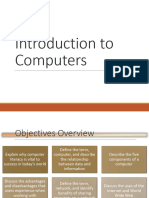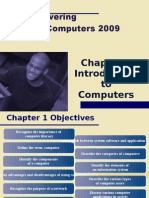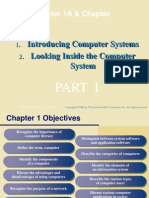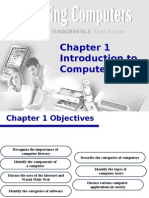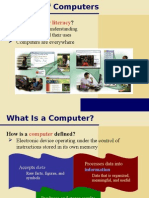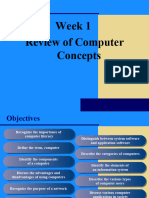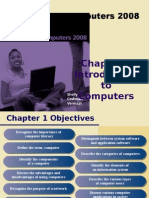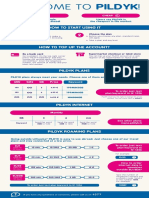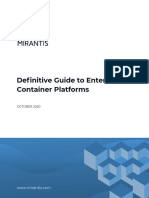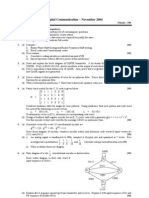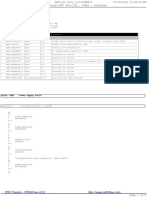Book:
Discovering Computers
Living in a Digital World
FUNDAMENTALS, 2011 EDITION
By
Gary B. Shelly
Misty E. Vermaat
� Chapter 1
Introduction to Computer
�What is Computer?
A computer is an electronic device,
operating under the control of
instructions stored in its own memory,
that can accept data, process the data
according to specified rules, produce
results, and store the results for future
use.
�Data & Information
Computers process data into information.
• Data is a collection of unprocessed items,
which can include text, numbers, images,
audio, and video.
• Information conveys meaning and is
useful to people.
�The Components of a
Computer
�system unit
• system unit is a case that contains electronic
components of the computer that are used to
process data.
• The circuitry of the system unit usually is part of or
is connected to a circuit board called the
motherboard.
• Two main components on the motherboard are the
processor and memory.
▫ The processor, also called the CPU (central processing
unit), is the electronic component that interprets and
carries out the basic instructions that operate the
computer.
▫ Memory consists of electronic components that store
instructions waiting to be executed and data needed
by those instructions.
�Storage Devices
• Storage holds data, instructions, and information for
future use
• A computer keeps data, instructions, and information on
storage media. Examples of storage media are USB flash
drives, hard disks, optical discs, and memory cards.
• A storage device records (writes) and/or retrieves (reads)
items to and from storage media.
▫ The average USB flash drive can hold about 4 billion
characters.
▫ The average hard disk can hold more than 320 billion
characters.
▫ A CD can hold from 650 million to 1 billion characters.
▫ Some DVDs can store two full-length movies or 17 billion
characters.
▫ Blu-ray Discs can store about 46 hours of standard video, or
100 billion characters.
�Communications Devices
• A communications device is a hardware
component that enables a computer to send
(transmit) and receive data, instructions, and
information to and from one or more computers or
mobile devices.
• A widely used communications device is a modem.
• Communications occur over cables, telephone
lines, cellular radio networks, satellites, and other
transmission media.
• Some transmission media, such as satellites and
cellular radio networks, are wireless, which
means they have no physical lines or wires
�Advantages of Using Computers
• Speed: Many computers process billions or trillions
of operations in a single second.
• Reliability: The electronic components in modern
computers are reliable because they rarely break or
fail.
• Consistency: Computers generate error-free results,
provided the input is correct and the instructions
work.
• Storage: Computers store enormous amounts of
data and make this data available for processing
anytime it is needed.
• Communications: Most computers today can
communicate with other computers, often
�Disadvantages of Using Computers
• Violation of Privacy: In many instances, where personal and
confidential records stored on computers were not protected
properly, individuals have found their privacy violated and
identities stolen.
• Public Safety: Adults, teens, and children around the world are
using computers to share publicly their photos, videos, journals,
music, and other personal information.
• Health Risks: Computer users can protect themselves from
health risks through proper workplace design, good posture
while at the computer, and appropriately spaced work breaks.
Two behavioral health risks are computer addiction and
technology overload.
• Impact on Environment: Green computing involves reducing the
electricity consumed and environmental waste generated when
using a computer. Strategies that support green computing
include recycling, regulating manufacturing processes,
extending the life of computers, and immediately donating or
�Networks and the Internet
• A network is a collection of computers and
devices connected together, often wirelessly, via
communications devices and transmission media.
• Networks allow computers to share resources,
such as hardware, software, data, and
information. Sharing resources saves time and
money.
• The Internet is a worldwide collection of
networks that connects millions of businesses,
government agencies, educational institutions,
and individuals.
�social networking Website
• The Web, short for World Wide Web, is one of the
more popular services on the Internet.
• The Web contains billions of documents called
Web pages.
• A Web page can contain text, graphics, animation,
audio, and video.
• A Website is a collection of related Web pages.
• Millions of people worldwide join online
communities, each called a social networking
Website or online social network, that encourage
members to share their interests, ideas, stories,
photos, music, and videos with other registered
users.
�social networking Website
• A blog is an informal Web site consisting of time stamped
articles in a diary or journal format, usually listed in
reverse chronological order.
• A microblog, such as Twitter, allows users to publish short
messages, usually between 100 and 200 characters, for
others to read.
• A podcast is recorded audio stored on a Web site that can
be downloaded to a computer or a portable media player
such as an iPod.
• A Web application is a Web site that allows users to access
and interact with software from any computer or device
that is connected to the Internet. Examples of software
available as Web applications include those that allow you
to send and receive e-mail messages, prepare your taxes,
organize digital photos, create documents, and play games.
�Computer Software
• Software, also called a program, is a series
of related instructions, organized for a
common purpose, that tells the computer
what task(s) to perform and how to perform
them. You interact with a program through
its user interface.
• The two categories of software are
▫ System software
Operating system
Utility Programs
▫ Application software.
�Installing and Running Programs
• Installing is the process of setting up
software to work with the computer,
printer, and other hardware.
• When you instruct the computer to run an
installed program, the computer loads it,
which means the program is copied from
storage to memory.
• Once in memory, the computer can carry
out, or execute, the instructions in the
program so that you can use the program.
�Software Development
• A programmer, sometimes called a
developer, is someone who develops
software or writes the instructions that
direct the computer to process data into
information.
• Popular programming languages include
C++, Visual C#, Visual Basic, JavaScript,
and Java.
�Categories of computer
• Personal computers (desktop)
• Mobile computers and mobile devices
• Game
• Mainframes
• Supercomputers
• Embedded computers
�personal computer
• A personal computer is a computer that can
perform all of its input, processing, output,
and storage activities by itself.
• Two popular architectures of personal
computers are the PC and the Apple.
• Two types of personal computers are
desktop computers and notebook
computers.
▫ A desktop computer is designed so that the
system unit, input devices, output devices,
and any other devices fit entirely on or under
a desk or table
�Mobile computers and mobile devices
�Mobile computers and mobile devices
• Notebook computer
• Tablet PC
• Smart phones, PDAs
• E-book reader
• Handheld computers
• Portable media players (I pod)
• Digital cameras
�Game console
• A game console is a mobile computing
device designed for single player or
multiplayer video games.
• Xbox
• Play stations
�server
• A server controls access to the hardware,
software, and other resources on a
network and provides a centralized
storage area for programs, data, and
information.
• Servers support from two to several
thousand connected computers at the
same time.
�Mainframe
• A mainframe is a large, expensive,
powerful computer that can handle
hundreds or thousands of connected users
simultaneously.
�Supercomputer
• A supercomputer is the fastest, most powerful
computer and the most expensive.
• The fastest supercomputers are capable of
processing more than one quadrillion instructions in
a single second.
• Applications requiring complex, sophisticated
mathematical calculations use super computers.
• Large-scale simulations and applications in
medicine, aerospace, automotive design, online
banking, weather forecasting, nuclear energy
research, and petroleum exploration use a
supercomputer
�Embedded Computers
• An embedded computer is a special-
purpose computer that functions as a
component in a larger product.
A variety of everyday products contain
embedded computers:
▫ Consumer electronics
▫ Home automation devices
▫ Automobiles
▫ Process controllers and robotics
▫ Computer devices and office machines
�Examples of computer usage
�Examples of computer usage
�Computer Applications in Society
• Education
• Finance
• Government
• Health care
• Science
• Publishing
• Manufacturing
• Travel









